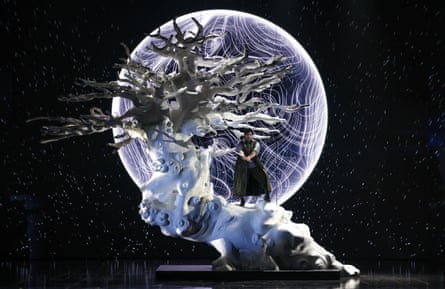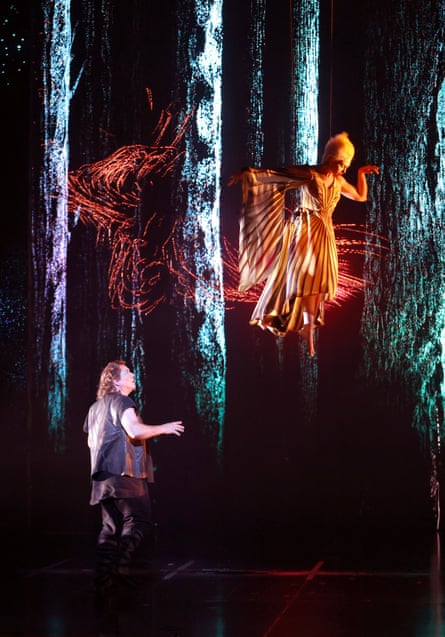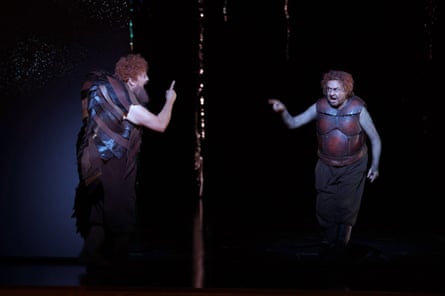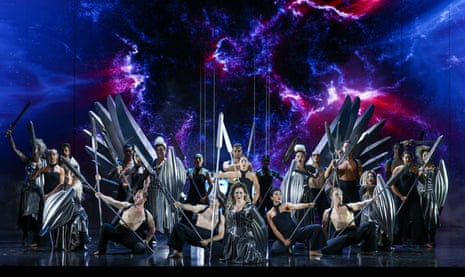A full staging of Richard Wagner’s Der Ring des Nibelungen – colloquially, the Ring Cycle – is a big deal anywhere: a 15-hour running time, split into four separate shows.
But for Brisbane to secure an international drawcard like this is particularly momentous, and here the city is getting something of a coup: a three-week series featuring cutting-edge production design, being billed by Opera Australia as the world’s first Ring Cycle with fully-digital backgrounds and scenery.
The production – whose first of three full cycles commenced last weekend – comprises 834 LED screens and 1.4TB of video content, some of which is triggered by thousands of sensors on the performers’ costumes; the sets, staging, costumes and tech took 27 semitrailer loads to get into town.

That this is a big Ring Cycle is saying something for a show that’s often compared to feats of human strength and endurance: it’s the Olympics or the Everest of opera or, more simply, a marathon. And in western performance, there’s no bigger challenge for performers: the shortest of the four parts is two hours and 35 minutes and the longest just under five hours. The singers are a special breed, who can be heard over huge orchestras for long stretches without fatiguing; with 2,000 pages of music to get through, the musicians need stamina too.
You could argue audiences have a tough job too, sitting in one spot to watch without distractions. That’s a feat usually left to the “Ring nuts”, as they’re known: completists who travel to productions around the world. According to Opera Australia, only a third of the audience of this production will be from Brisbane, with 9% coming from overseas – some from as far as the US and Europe.
And as someone who usually balks at anything longer than three hours, my assignment was daunting: to sit in on all four of the final dress rehearsals of the full suite, and watch more than 15 hours of live opera in six days.
But with tickets to each part costing $165-625, it was also a once in a lifetime opportunity: the first fully staged Ring Cycle to come to my home town in its 147-year history. (It’s never been done in Sydney either; the 83 musicians can’t fit in the Opera House’s orchestra pit.)

The production is directed and designed by Chen Shi-Zheng, who has a background in cinema, and whose digital staging is more than a gimmick. It’s intent is to meet the challenge of an increasingly attention-deficient audience; to attract and sustain their interest, and create a work that is thematically – and literally – universal in scope.
It’s immersive from the start, with digital displays spanning the breadth and height of the stage. Generated by the content designer Leigh Sachwitz and flora&faunavisions, images of nature – including the sun, moon, eclipses and the elemental – place the action in a world we all share, and add a layer of existential contemplation; in the prologue, Das Rheingold, we are submerged in a glorious green wall of water, while dancing northern lights and nebulae draw us into the gods’ celestial realm.

And so to the plot. Drawn from Nordic and German mythology, the Ring Cycle features gods, mortals, giants, dwarves and water maidens, and follows the pursuit of a ring empowered to rule the world, which is stolen – and then cursed. This story plays out against multigenerational sagas largely revolving around the lord of the gods, Wotan, husband of the goddess of marriage, Fricka, but who fathers children with two others: the goddess of the Earth, Erda (the nine Valkyries, led by his favourite, Brunnhilde), and a mortal (twins Siegmund and Sieglinde).
after newsletter promotion

You don’t need to be a buff to appreciate the descriptive clarity of Wagner’s leitmotifs and innovative orchestration, which here include new instruments and even tuned anvils for the Nibelung. The elite singers make awe-inspiring use of their voices; international artists Lise Lindstrom and Stefan Vinke are rightfully celebrated for their signature roles as Brunnhilde and Siegfried, but they don’t outshine the Australian talent. Many are curious to see rising star Anna-Louise Cole transition from Sieglinde to Brunnhilde in the final cycle, which premieres on Friday 13 December.
Inspired set pieces deliver pure theatrical spectacle. In part two, Die Walküre (The Valkyrie, who guide slain warriors to Wotan’s Valhalla), the arrival of Brunnhilde’s eight sisters on a steel phoenix jet, descending from the sky to Ride of the Valkyries, deserves applause. Another show-stopper is the huge metal dragon, with a spine of real flames.
In Akasia Ruth Inchaustegui’s choreography, aerial sequences offer the captivating illusion of Rhinemaidens diving, twisting and somersaulting beneath the river’s surface in Das Rheingold; and the interactive digital tracking of a flitting woodland bird in the third part, Siegfried. Played out against an exquisite backdrop of opalesque greens and blues illuminating a night-time forest, the scene’s mesmerising beauty made it my favourite.
Anita Yavich’s imaginative costumes provide a redolent framework for the characters, such as the beetle-like Nibelung dwarves Alberich (Warwick Fyfe) and Mime (Andreas Conrad), and the final instalment’s fate-weaving Norns, whose skirts of coiled hair look like beehives lit from within.

There’s delicious taunting banter and physical comedy scattered among the drama. Cole and Rosario La Spina make sympathetic characters of the incestuous twins, Sieglinde and Siegmund; and as their son Siegfried, the German tenor Vinke brings youthful charisma and humour to an imperfect hero. Perhaps the biggest surprise is the strength and complexity of the female protagonists Fricka (Deborah Humble) and Brunnhilde (Lindstrom).
After Das Rheingold’s gentle 155 minutes, the following three shows are much longer, but each have two welcome (and necessary) intervals. And yet across the show’s 15 hours, my alertness rarely flagged; the scale of the production and its sensory impact keeps it compelling, and the performances and pacing maintain momentum. As the Cycle headed to an apocalyptic conclusion in Götterdämmerung (Twilight of the Gods), I felt exhilarated – not only by Brunnhilde’s courage and wisdom to do what the power-hungry men couldn’t, but by the endorphin hit of reaching the finish line. (I even went back for the first two premieres, which took my cumulative time watching the Ring Cycle to nearly 22 hours across nine days.)

To see all four shows is a significant investment that only a few can afford – but with two cycles left across two weeks, audiences are still able to test the water with a single ticket first. For those wary of opera as a genre, perhaps see this instead as the music drama that Wagner intended: you’ll find parallels with epics like The Lord of the Rings, Game of Thrones and Vikings, and you may find yourself – like I did – cast under its spell.
Wagner’s Ring Cycle is being performed at the Queensland Performing Arts Centre through December, with the second cycle commencing on 8 December and the third starting on 15 December
